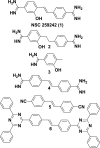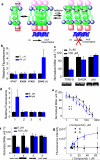Targeting the lateral interactions of transmembrane domain 5 of Epstein-Barr virus latent membrane protein 1
- PMID: 22609737
- PMCID: PMC3378808
- DOI: 10.1016/j.bbamem.2012.05.013
Targeting the lateral interactions of transmembrane domain 5 of Epstein-Barr virus latent membrane protein 1
Abstract
The lateral transmembrane protein-protein interaction has been regarded as "undruggable" despite its importance in many biological processes. The homo-trimerization of transmembrane domain 5 (TMD-5) of latent membrane protein 1 (LMP-1) is critical for the constitutive oncogenic activation of the Epstein-Barr virus (EBV). Herein, we report a small molecule agent, NSC 259242 (compound 1), to be a TMD-5 self-association disruptor. Both the positively charged acetimidamide functional groups and the stilbene backbone of compound 1 are essential for its inhibitory activity. Furthermore, cell-based assays revealed that compound 1 inhibits full-length LMP-1 signaling in EBV infected B cells. These studies demonstrated a new strategy for identifying small molecule disruptors for investigating transmembrane protein-protein interactions.
Copyright © 2012 Elsevier B.V. All rights reserved.
Figures







Similar articles
-
Repositioning antimicrobial agent pentamidine as a disruptor of the lateral interactions of transmembrane domain 5 of EBV latent membrane protein 1.PLoS One. 2012;7(10):e47703. doi: 10.1371/journal.pone.0047703. Epub 2012 Oct 19. PLoS One. 2012. PMID: 23094078 Free PMC article.
-
The cytoplasmic amino-terminus of the Latent Membrane Protein-1 of Epstein-Barr Virus: relationship between transmembrane orientation and effector functions of the carboxy-terminus and transmembrane domain.Oncogene. 2001 Aug 30;20(38):5313-30. doi: 10.1038/sj.onc.1204689. Oncogene. 2001. PMID: 11536044
-
Transmembrane domains 1 and 2 of the latent membrane protein 1 of Epstein-Barr virus contain a lipid raft targeting signal and play a critical role in cytostasis.J Virol. 2003 Mar;77(6):3749-58. doi: 10.1128/jvi.77.6.3749-3758.2003. J Virol. 2003. PMID: 12610149 Free PMC article.
-
LMP1 structure and signal transduction.Semin Cancer Biol. 2001 Dec;11(6):435-44. doi: 10.1006/scbi.2001.0410. Semin Cancer Biol. 2001. PMID: 11669605 Review.
-
Promotion of metastasis in nasopharyngeal carcinoma by Epstein-Barr virus latent membrane protein-1.Histol Histopathol. 2002;17(3):845-50. doi: 10.14670/HH-17.845. Histol Histopathol. 2002. PMID: 12168795 Review.
Cited by
-
Repositioning antimicrobial agent pentamidine as a disruptor of the lateral interactions of transmembrane domain 5 of EBV latent membrane protein 1.PLoS One. 2012;7(10):e47703. doi: 10.1371/journal.pone.0047703. Epub 2012 Oct 19. PLoS One. 2012. PMID: 23094078 Free PMC article.
-
Viral Membrane Fusion and the Transmembrane Domain.Viruses. 2020 Jun 27;12(7):693. doi: 10.3390/v12070693. Viruses. 2020. PMID: 32604992 Free PMC article. Review.
-
A Hydrophobic Target: Using the Paramyxovirus Fusion Protein Transmembrane Domain To Modulate Fusion Protein Stability.J Virol. 2019 Aug 13;93(17):e00863-19. doi: 10.1128/JVI.00863-19. Print 2019 Sep 1. J Virol. 2019. PMID: 31217248 Free PMC article.
-
Targeting trimeric transmembrane domain 5 of oncogenic latent membrane protein 1 using a computationally designed peptide.Chem Sci. 2019 Jun 27;10(32):7584-7590. doi: 10.1039/c9sc02474c. eCollection 2019 Aug 28. Chem Sci. 2019. PMID: 31588309 Free PMC article.
-
Drugging Membrane Protein Interactions.Annu Rev Biomed Eng. 2016 Jul 11;18:51-76. doi: 10.1146/annurev-bioeng-092115-025322. Epub 2016 Feb 5. Annu Rev Biomed Eng. 2016. PMID: 26863923 Free PMC article. Review.
References
-
- Sackett DL, Sept D. Protein-protein interactions: making drug design second nature. Nat. Chem. 2009;1:596–597. - PubMed
-
- Arkin MR, Wells JA. Small-molecule inhibitors of protein-protein interactions: progressing towards the dream. Nat. Rev. Drug Discov. 2004;3:301–317. - PubMed
-
- Wilson AJ. Inhibition of protein-protein interactions using designed molecules. Chem. Soc. Rev. 2009;38:3289–3300. - PubMed
-
- Yin H. Exogenous agents that target transmembrane domains of proteins. Angew. Chem. Int. Ed. Engl. 2008;47:2744–2752. - PubMed
-
- Zhao TX, Martinko AJ, Le VH, Zhao J, Yin H. Development of agents that modulate protein-protein interactions in membranes. Curr. Pharm. Des. 2010;16:1055–1062. - PubMed
Publication types
MeSH terms
Substances
Grants and funding
LinkOut - more resources
Full Text Sources
Research Materials

